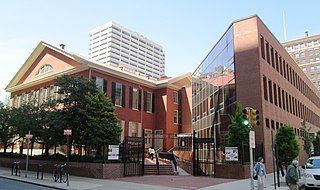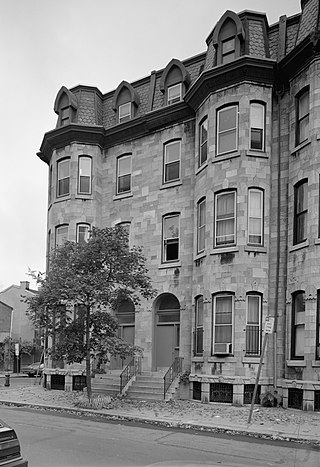
William Still was an African-American abolitionist based in Philadelphia, Pennsylvania. He was a conductor of the Underground Railroad and was responsible for aiding and assisting at least 649 slaves to freedom towards North. Still was also a businessman, writer, historian and civil rights activist. Before the American Civil War, Still was chairman of the Vigilance Committee of the Pennsylvania Anti-Slavery Society, named the Vigilant Association of Philadelphia. He directly aided fugitive slaves and also kept records of the people served in order to help families reunite.

Frances Ellen Watkins Harper was an American abolitionist, suffragist, poet, temperance activist, teacher, public speaker, and writer. Beginning in 1845, she was one of the first African-American women to be published in the United States.

Overbrook is an historic neighborhood that is located in the Commonwealth of Pennsylvania, United States. It is situated northwest of West Philadelphia, Philadelphia.

Bella Vista, Italian for "beautiful sight", is a neighborhood in the South Philadelphia section of Philadelphia, Pennsylvania, United States.

The Maggie L. Walker National Historic Site is a United States National Historic Landmark and a National Historic Site located at 110½ E. Leigh Street on "Quality Row" in the Jackson Ward neighborhood of Richmond, Virginia. The site was designated a U.S. National Historic Landmark in 1975. The National Historic Site was established in 1978 to tell the story of the life and work of Maggie L. Walker (1867-1934), the first woman to serve as president of a bank in the United States. It was built by George W. Boyd, father of physician, Sarah Garland Boyd Jones. The historic site protects the restored and originally furnished home of Walker. Tours of the home are offered by National Park Service rangers.

Carter G. Woodson Home National Historic Site at 1538 9th Street NW, in the Shaw neighborhood of Washington, D.C., preserves the home of Carter G. Woodson (1875–1950). Woodson, the founder of Black History Month, was an African-American historian, author, and journalist.

The Thomas Eakins House is a historic house at 1727-29 Mount Vernon Street in the Spring Garden section of Philadelphia, Pennsylvania, USA. Built about 1854, it was for most of his life the home of Thomas Eakins (1844-1916), one of the most influential American artist of the late 19th century. It was designated a National Historic Landmark in 1965, and is now home to a local artist cooperative.

The First Unitarian Church of Philadelphia is a Unitarian Universalist congregation located at 2125 Chestnut Street in Philadelphia, Pennsylvania. As a regional Community Center it sponsors cultural, educational, civic, wellness and spiritual activities.

The Ida B. Wells-Barnett House was the residence of civil rights advocate Ida B. Wells (1862–1931) and her husband Ferdinand Lee Barnett from 1919 to 1930. It is located at 3624 S. Dr. Martin Luther King Jr. Drive in the Douglas community area of Chicago, Illinois. It was designated a Chicago Landmark on October 2, 1995. It was listed on the National Register of Historic Places and as a National Historic Landmark on May 30, 1974.

The Will Marion Cook House is a historic townhouse at 221 West 138th Street, in the part of Harlem known as Strivers' Row in Manhattan, New York City. It was the home of Will Marion Cook (1869-1944), a leading African-American musician and composer of the period, from 1918 until his death in 1944. Cook was a major influence on later musicians including Sidney Bechet, Duke Ellington, and Josephine Baker. It was declared a National Historic Landmark in 1976.

The New York Amsterdam News Building is a historic rowhouse at 2293 Seventh Avenue in the Harlem neighborhood of Manhattan, New York City. It is historically significant as the publishing home of the New York Amsterdam News between 1916 and 1938. During this period, the newspaper became one of the nation's most influential publications covering African-American issues. It was designated a National Historic Landmark in 1976. The Amsterdam News now publishes out of a building at 2340 Frederick Douglass Boulevard.

The Race Street Meetinghouse is an historic and still active Quaker meetinghouse at 1515 Cherry Street at the corner of N. 15th Street in the Center City area of Philadelphia, Pennsylvania. The meetinghouse served as the site of the Yearly Meeting of the Hicksite sect of the Religious Society of Friends (Quakers) from 1857 to 1955.

The Edward Drinker Cope House is a historic house located at 2100–2102 Pine Street in Center City Philadelphia, Pennsylvania. Built in 1880, it was a longtime home of Edward Drinker Cope (1840–1897), a prolific geologist and paleontologist and noted herpetologist who was one of the leading natural scientists of the 19th century United States. It was declared a National Historic Landmark in 1975.

The Reynolds-Morris House is an historic house which is located at 225 South 8th Street in the Washington Square West neighborhood of Philadelphia, Pennsylvania. Built between 1786 and 1787 by John and William Reynolds, it is a well-preserved example of a Philadelphia Georgian townhouse.

The Henry O. Tanner House is a historic house at 2908 West Diamond Street in Philadelphia, Pennsylvania, USA. It was from 1872 to 1888 the childhood home of Henry Ossawa Tanner (1859-1937), an African-American artist who was the first of his race to be elected to National Academy of Design. This rowhouse was designated a National Historic Landmark in 1976.

The Charlotte Forten Grimké House is a historic house at 1608 R Street NW in the Dupont Circle neighborhood of Northwest Washington, D.C., United States. From 1881 to 1886, the house was home to Charlotte Forten Grimké (1837–1914), an African-American abolitionist and educator, one of the first Northerners to enter Union-controlled areas of the South during the American Civil War in order to teach freedmen and their children. The house was designated a National Historic Landmark in 1976.

The Scott Joplin House State Historic Site is located at 2658 Delmar Boulevard in St. Louis, Missouri. It preserves the Scott Joplin Residence, the home of composer Scott Joplin from 1901 to 1903. The house and its surroundings are maintained by the Missouri Department of Natural Resources as a state historic site. The house was added to the National Register of Historic Places and designated a U.S. National Historic Landmark in 1976.

The Paul Robeson House was the home of internationally renowned American bass-baritone concert singer, actor of film and stage, All-American and professional athlete, writer, multi-lingual orator, human rights activist, and lawyer Paul Robeson from 1966 until 1976. Located in West Philadelphia, the Robeson House produces, presents and promotes traveling lectures, concerts and exhibits so that learning about Robeson is accessible to all ages and cultures.

The Marian Anderson House is a historic home located in the Southwest Center City neighborhood of Philadelphia, Pennsylvania. Built circa 1870 in the same neighborhood where opera singer and civil rights advocate Marian Anderson was born 27 years later, this two-story, brick rowhouse dwelling was designed in the Italianate style. Purchased by Anderson in 1924, the same year she became the first African-American concert artist to record spirituals for a major American recording company, she continued to reside here until 1943. The house is currently home to the Marian Anderson Museum and Historical Society.

This article documents the history of African-Americans or Black Philadelphians in the city of Philadelphia, Pennsylvania.

























